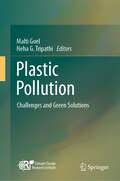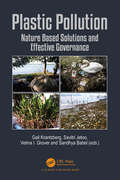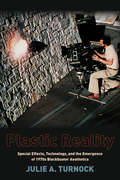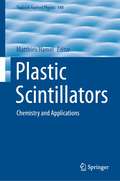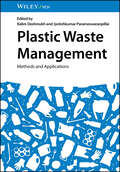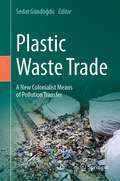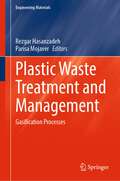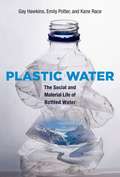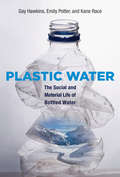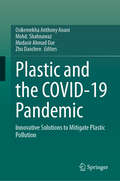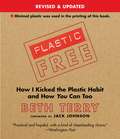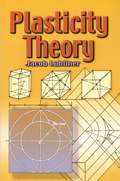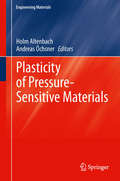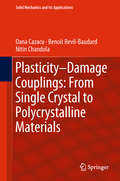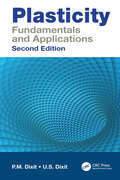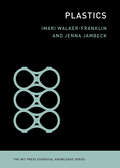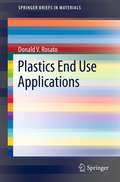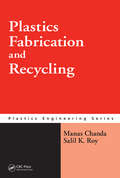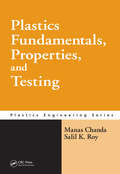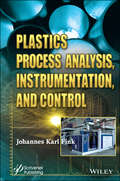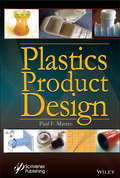- Table View
- List View
Plastic Pollution: Challenges and Green Solutions
by Malti Goel Neha G. TripathiThis book provides a comprehensive understanding of the challenges being faced in managing plastic waste and showcases innovative solutions that can mitigate the adverse effects of plastic pollution on the environment. This timely book brings together a multi-disciplinary group of experts to outline the scale and complexity of the plastics pollution issue while advancing innovative and inclusive solutions. Spanning perspectives from policy, industry, advocacy, technology, and academia, the book provides a comprehensive understanding of plastic waste sources, impacts, and management approaches. Policymakers, municipal authorities, industry leaders, entrepreneurs, researchers, students, advocates and informed citizens seeking to drive progress on sustainable plastic waste management will find crucial insights and inspirational models in this book.
Plastic Pollution: Nature Based Solutions and Effective Governance (Water)
by Velma I. Grover Gail Krantzberg Sandhya Babel Savitri JetooPlastics show up in every area of our lives. They are durable, cheap and light, properties that make them attractive but also problematic for the environment. The focus of this book is not just to highlight the problem of plastics, its definition, and how plastic pollution is impacting human health and environment but also to look at some best practices in both nature based solutions and in the field of law and policies. The first section of the book focuses on plastic pollution – it’s origin, relationship to climate change, linear/circular economy, followed by sustainable plastics, scientific solutions, and how policies can address plastic pollution. This includes looking at better designs, more sustainable feedstocks, and partnerships between various stakeholders worldwide including USA, China, Canada, South Korea, Thailand. This book will interest those who are associated with the production industry, packaging industry, and waste management industry as well as, academicians, students and policymakers.
Plastic Reality: Special Effects, Technology, and the Emergence of 1970s Blockbuster Aesthetics (Film and Culture Series)
by Julie TurnockJulie A. Turnock tracks the use and evolution of special effects in 1970s filmmaking, a development as revolutionary to film as the form's transition to sound in the 1920s. Beginning with the classical studio era's early approaches to special effects, she follows the industry's slow build toward the significant advances of the late 1960s and early 1970s, which set the stage for the groundbreaking achievements of 1977. Turnock analyzes the far-reaching impact of the convincing, absorbing, and seemingly unlimited fantasy environments of that year's iconic films, dedicating a major section of her book to the unparalleled innovations of Star Wars and Close Encounters of the Third Kind. She then traces these films' technological, cultural, and aesthetic influence into the 1980s in the deployment of optical special effects as well as the "not-too-realistic" and hyper-realistic techniques of traditional stop motion and Showscan. She concludes with a critique of special effects practices in the 2000s and their implications for the future of filmmaking and the production and experience of other visual media.
Plastic Scintillators: Chemistry and Applications (Topics in Applied Physics #140)
by Matthieu HamelThis book introduces the physics and chemistry of plastic scintillators (fluorescent polymers) that are able to emit light when exposed to ionizing radiation, discussing their chemical modification in the early 1950s and 1960s, as well as the renewed upsurge in interest in the 21st century. The book presents contributions from various researchers on broad aspects of plastic scintillators, from physics, chemistry, materials science and applications, covering topics such as the chemical nature of the polymer and/or the fluorophores, modification of the photophysical properties (decay time, emission wavelength) and loading of additives to make the material more sensitive to, e.g., fast neutrons, thermal neutrons or gamma rays. It also describes the benefits of recent technological advances for plastic scintillators, such as nanomaterials and quantum dots, which allow features that were previously not achievable with regular organic molecules or organometallics.
Plastic Waste Management: Methods and Applications
by Jyotishkumar Parameswaranpillai Kalim DeshmukhPlastic Waste Management Comprehensive resource on innovative and breakthrough developments in plastic waste management, covering a wide range of processing techniques and applications Plastic Waste Management offers a complete guide to the best plastic waste management practices through recycling, incineration, landfill, and other processes, discusses applications of plastic waste management including energy generation, biochemical production, construction, and food packaging, covering current challenges relating to plastic waste, explaining the sources of waste and their routes into the environment, and providing systematic coverage of plastic waste treatment methods, including mechanical processing, monomerization, blast furnace feedstock, gasification, and thermal recycling. The book also discusses different biodegradation mechanisms of plastic wastes and ecotoxicity and ecological Implications of marine plastic debris. From a cultural perspective, the book provides information regarding environmental and health implications, societal issues, and current challenges associated with plastic waste management. Written by leading experts in the field and edited by two highly qualified academics, Plastic Waste Management covers specific sample topics such as: A a roadmap towards a circular economy and environmental sustainability via effective management strategies for plastic wastesImplementation of an analytical hierarchy process for developing better waste collection systems, and chemical recycling of plastic waste for sustainable developmentMechanisms, perspectives, and challenges for natural biodegradation of plastic wastes, and conversion of plastic wastes into value added materialsPlastic wastes management and disposal in developing countries, and challenges and strategies for plastic waste management during and post COVID-19 pandemic Plastic Waste Management is a highly valuable resource for scientists and researchers working in the fields of environmental science, environmental engineering, and plastic engineering towards the goal of developing sustainable materials, along with graduate and postgraduate students in related programs of study, and professionals and engineers in related industries.
Plastic Waste Trade: A New Colonialist Means of Pollution Transfer
by Sedat GündoğduThis contributed volume takes a holistic view of the international waste trade and in doing so argues that the transfer of plastic waste from mainly Global North to primarily Global South countries constitutes a form of 21st Century colonialism. The book first describes the history of the plastic waste trade, from toxic disasters in the 1970s and 1980s through the Basel Convention on the Control of Transboundary Movements of Hazardous Wastes and Their Disposal in 1989 through China’s 2018 implementation of a “National Sword” policy that effectively banned importation of plastic waste. From there, the authors explore both the legal trade in plastic waste and the underground illegal trade in waste, arguing that both lead to devastating impacts on ecosystems, workers, and communities in receiving countries and highlighting how countries that receive waste are often less equipped to process it than the countries that export waste. The last section of the book presents cases from countrieson the receiving end of the plastic waste trade, highlighting inherent problems from sociological and environmental justice perspectives.
Plastic Waste Treatment and Management: Gasification Processes (Engineering Materials)
by Rezgar Hasanzadeh Parisa MojaverThis book offers an overview of the gasification process as a crucial thermochemical method for addressing the problem of plastic waste. The authors explore various strategies to minimize post-consumer plastic waste and provide a detailed analysis of one of the most promising methods for converting it into high-value products. The chapters reports on the gasification process and its potential for transforming plastic waste into energy and valuable resources. Readers will learn about methods for reducing plastic waste and treating them using the gasification process. Thermochemical processes for upcycling plastic waste into products with higher value, such as chemicals, fuels, and advanced materials are also covered in this book.
Plastic Water
by Kane Race Emily Potter Gay HawkinsHow did branded bottles of water insinuate themselves into our daily lives? Why did water become an economic good -- no longer a common resource but a commercial product, in industry parlance a "fast moving consumer good," or FMCG? Plastic Water examines the processes behind this transformation. It goes beyond the usual political and environmental critiques of bottled water to investigate its multiplicity, examining a bottle of water's simultaneous existence as, among other things, a product, personal health resource, object of boycotts, and part of accumulating waste matter. Throughout, the book focuses on the ontological dimensions of drinking bottled water -- the ways in which this habit enacts new relations and meanings that may interfere with other drinking water practices.The book considers the assemblage and emergence of a mass market for water, from the invention of the polyethylene terephthalate (PET) bottle in 1973 to the development of "hydration science" that accompanied the rise of jogging in the United States. It looks at what bottles do in the world, tracing drinking and disposal practices in three Asian cities with unreliable access to safe water: Bangkok, Chennai, and Hanoi. And it considers the possibility of ethical drinking, examining campaigns to "say no" to the bottle and promote the consumption of tap water in Canada, the United States, and Australia.
Plastic Water: The Social and Material Life of Bottled Water (The\mit Press Ser.)
by Kane Race Emily Potter Gay HawkinsHow and why branded bottles of water have insinuated themselves into our daily lives, and what the implications are for safe urban water supplies.How did branded bottles of water insinuate themselves into our daily lives? Why did water become an economic good—no longer a common resource but a commercial product, in industry parlance a “fast moving consumer good,” or FMCG? Plastic Water examines the processes behind this transformation. It goes beyond the usual political and environmental critiques of bottled water to investigate its multiplicity, examining a bottle of water's simultaneous existence as, among other things, a product, personal health resource, object of boycotts, and part of accumulating waste matter. Throughout, the book focuses on the ontological dimensions of drinking bottled water—the ways in which this habit enacts new relations and meanings that may interfere with other drinking water practices.The book considers the assemblage and emergence of a mass market for water, from the invention of the polyethylene terephthalate (PET) bottle in 1973 to the development of “hydration science” that accompanied the rise of jogging in the United States. It looks at what bottles do in the world, tracing drinking and disposal practices in three Asian cities with unreliable access to safe water: Bangkok, Chennai, and Hanoi. And it considers the possibility of ethical drinking, examining campaigns to “say no” to the bottle and promote the consumption of tap water in Canada, the United States, and Australia.
Plastic and Polymer Industry by Region: Production, Consumption and Waste Management in the African Continent
by Ololade OlatunjiThis book addresses the need for a technical guided thought on production, consumption, and waste management of plastic and polymers in the African continent. Issues such as resource availability, processing technologies, plastic policies, and much more are covered in the book. While Africa is made up of several different countries which might be different from each other in many ways, these countries within the African continent have some commonalities such as region, some shared history, resources, and some shared policies through organizations such as the African Union, African Free trade Zone, and ECOWAS. With a population of over a billion, the African continent has become an attractive market for various businesses. Several publications in recent years have pushed for the advancement of the African continent toward increased manufacturing as a road to development. This inevitably includes the plastics and other polymers industry. Careful consideration must be taken to ensure that this growth will focus on more sustainable and greener manufacturing; otherwise, this anticipated growth in the plastics and polymer industry will only spell increased pollution and worsening of the environment.
Plastic and the COVID-19 Pandemic: Innovative Solutions to Mitigate Plastic Pollution
by Mohd. Shahnawaz Zhu Daochen Mudasir Ahmad Dar Osikemekha Anthony AnaniFrom masks and face shields through at-home tests and sanitizer bottles, many of the tools we used to keep safe during the global COVID-19 pandemic had two things in common: first, they were at least in part made of plastic, and second, they were disposable. But what was the fate of all of the plastics that we used throughout the pandemic, and how has the management of plastic waste changed in the COVID years? This book showcases the research findings and to unravel the current scenario of plastic pollution due to the ongoing COVID-19 pandemic and goes on to report innovative ways to mitigate increasing plastic pollution beyond personal protective equipment (PPE). Through twelve chapters, this volume offers a cutting-edge overview the impact of COVID-19-associated plastic pollution in environmental and economic terms. It also analyzes the effects of plastic waste on human health.
Plastic-Free: How I Kicked the Plastic Habit and How You Can Too
by Beth Terry"Guides readers toward the road less consumptive, offering practical advice and moral support while making a convincing case that individual actions . . . do matter. ” --Elizabeth Royte, author, Garbage Land and Bottlemania Like many people, Beth Terry didn’t think an individual could have much impact on the environment. But while laid up after surgery, she read an article about the staggering amount of plastic polluting the oceans, and decided then and there to kick her plastic habit. In Plastic-Free, she shows you how you can too, providing personal anecdotes, stats about the environmental and health problems related to plastic, and individual solutions and tips on how to limit your plastic footprint. Presenting both beginner and advanced steps, Terry includes handy checklists and tables for easy reference, ways to get involved in larger community actions, and profiles of individuals--Plastic-Free Heroes--who have gone beyond personal solutions to create change on a larger scale. Fully updated for the paperback edition, Plastic-Free also includes sections on letting go of eco-guilt, strategies for coping with overwhelming problems, and ways to relate to other people who aren’t as far along on the plastic-free path. Both a practical guide and the story of a personal journey from helplessness to empowerment, Plastic-Free is a must-read for those concerned about the ongoing health and happiness of themselves, their children, and the planet.
Plasticity Theory (Dover Books on Engineering)
by Jacob LublinerThe aim of Plasticity Theory is to provide a comprehensive introduction to the contemporary state of knowledge in basic plasticity theory and to its applications. It treats several areas not commonly found between the covers of a single book: the physics of plasticity, constitutive theory, dynamic plasticity, large-deformation plasticity, and numerical methods, in addition to a representative survey of problems treated by classical methods, such as elastic-plastic problems, plane plastic flow, and limit analysis; the problem discussed come from areas of interest to mechanical, structural, and geotechnical engineers, metallurgists and others.The necessary mathematics and basic mechanics and thermodynamics are covered in an introductory chapter, making the book a self-contained text suitable for advanced undergraduates and graduate students, as well as a reference for practitioners of solid mechanics.
Plasticity of Boronized Layers
by M. G. Krukovich B. A. Prusakov I. G. SizovThis book presents the physico-technical basis and current state of the technology of boronized layers. Special attention is given to the layer structure and morphology of allocated phases and distributions in a superficial zone of chemical compounds. Two- and multi-component phases of alloys and diffusion processes in a self-organizing mode are discussed. Surface hardening by boronizing increases the life time of mechanical tools. This is important for the mining industry, agriculture, textile and chemical industry. The book is important for thermochemical treatment and surface hardening of metals and alloys.
Plasticity of Pressure-Sensitive Materials
by Andreas Öchsner Holm AltenbachClassical plasticity theory of metals is independent of the hydrostatic pressure. However if the metal contains voids or pores or if the structure is composed of cells, this classical assumption is no more valid and the influence of the hydrostatic pressure must be incorporated in the constitutive description. Looking at the microlevel, metal plasticity is connected with the uniform planes of atoms organized with long-range order. Planes may slip past each other along their close-packed directions. The result is a permanent change of shape within the crystal and plastic deformation. The presence of dislocations increases the likelihood of planes slipping. Nowadays, the theory of pressure sensitive plasticity is successfully applied to many other important classes of materials (polymers, concrete, bones etc. ) even if the phenomena on the micro-level are different to classical plasticity of metals. The theoretical background of this phenomenological approach based on observations on the macro-level is described in detail in this monograph and applied to a wide range of different important materials in the last part of this book.
Plasticity-Damage Couplings: From Single Crystal to Polycrystalline Materials (Solid Mechanics and Its Applications #253)
by Oana Cazacu Benoit Revil-Baudard Nitin ChandolaOffering a well-balanced blend of theory and hands-on applications, this book presents a unified framework for the main dissipative phenomena in metallic materials: plasticity and damage. Based on representation theory for tensor functions and scale-bridging theorems, this framework enables the development of constitutive models that account for the influence of crystallographic structures and deformation mechanisms on the macroscopic behavior. It allows readers to develop a clear understanding of the range of applicability of any given model, as well as its capabilities and limitations, and provides procedures for parameter identification along with key concepts necessary to solve boundary value problems, making it useful to both researchers and engineering practitioners. Although the book focuses on new contributions to modeling anisotropic materials, the review of the foundations of plasticity and models for isotropic materials, completed with detailed mathematical proofs mean that it is self-consistent and accessible to graduate students in engineering mechanics and material sciences.
Plasticity: Fundamentals and Applications
by U.S. Dixit P.M. DixitAll materials undergo some deformation under the application of a load. When the load is removed, a solid material may return to its original state or retain some deformation. Plasticity: Fundamentals and Applications places emphasis on the fundamentals of elastic-plastic deformation. This book includes topics such as stress, strain, constitutive relations, fracture, anisotropy, and contact problems. In addition the text also provides a discussion of updated Lagrangian and Eulerian formulations.
Plasticity: Fundamentals and Applications
by U.S. Dixit P.M. DixitThis book covers the fundamentals of the elastic-plastic deformation including stress, strain, constitutive relations, fracture, anisotropy and contact problems along with a discussion of updated Lagrangian and Eulerian formulations. The second edition includes new material on thermal effects in plasticity and an introduction to crystal plasticity with review of all the chapters including more solved examples and a solutions manual.Features: Explores the physics behind the equations and computational aspects of plasticity. Reviews the latest developments in fracture mechanics including elasto-plastic behavior of solids. Explains anisotropy, thermal effects, dynamics plasticity, contact mechanics and ductile fracture. Provides introduction to crystal plasticity. Includes real-life examples in the form of solved and unsolved examples, and practice problems including MATLAB® and solutions manual. This textbook is aimed at senior undergraduate and graduate students in mechanics and mechanical engineering.
Plastics (The MIT Press Essential Knowledge series)
by Imari Walker-Franklin Jenna JambeckA comprehensive introduction to the plastics life cycle—the impacts on our lives, our future, and our planet—and the actions we can take.Everywhere we look, we are surrounded by plastics: perhaps you have a book in one hand and your phone—made of various metals, plastics, and glass—in the other, or you are reading this on your polyurethane mattress after having flipped on a plastic light switch. In this Essential Knowledge series volume, Imari Walker-Franklin and Jenna Jambeck provide a deep exploration of the entire life of plastic things—plastics production and use, plastic waste generation and management, the environmental and societal impacts of plastics in our environment, and, finally, the policies that can help reduce pollution caused by our heavy use of plastics. One of the most current and comprehensive summaries on the subject, Plastics covers not only ocean and terrestrial plastic pollution but also the potential harms of microplastics on the human body. The authors also explain why we use plastic for so many products, how trash ends up in even the most remote corners of our world, and the alternatives and interventions that can help address our overreliance on this virtually imperishable material. As easily digestible to read as it is important, this book empowers its readers with the crucial knowledge and information they need to make thoughtful consumer choices, influence change, and spark inspiration.
Plastics Additives and Testing
by Muralisrinivasan Natamai Subramanian"Plastics Additives and Testing" is a practical book for engineers and operators and discusses both inorganic and organic chemicals that are widely used as additives in plastics processing operations. It is common practice today to use analytical techniques to improve plastics processing. Because it is critically important to manufacture quality products, a reasonable balance must be drawn between control requirements and parameters for improved processing method with respect to plastics additives. This book serves to implement this balance in the manufacturing line. Written by a successful, international consultant with an excellent publishing track record, it combines plastics additives, testing and quality control and is a valuable and critical book for engineers and operators to have when performing their tasks.
Plastics End Use Applications
by Donald V. RosatoPlastics End Use Applications is a SpringerBrief designed to keep professionals in the plastics industry abreast of key technical developments, business strategies and marketing initiatives in plastics and competitive materials that impact sales and usage. It is concisely focused on the five major competitive material areas-plastic, metal, paper and wood, rubber, and glass and ceramic-and how they interact in the twenty major plastic end-use market segments. For the global plastics professional, this book offers a way to enhance plastics technical and marketing insights. Plastics End Use Applications is of most value to manufacturing engineers, research and development professionals and general researchers interested in plastics and materials science.
Plastics Fabrication and Recycling (Plastics Engineering)
by Manas Chanda Salil K. RoyDerived from the fourth edition of the well-known Plastics Technology Handbook, Plastics Fabrication and Recycling presents the molding and fabrication processes of plastics as well as several important fe
Plastics Fundamentals, Properties, and Testing (Plastics Engineering)
by Manas Chanda Salil K. RoyDerived from the fourth edition of the well-known Plastics Technology Handbook, Plastics Fundamentals, Properties, and Testing covers the behavior, characterization, and evaluation of polymers. With a luci
Plastics Process Analysis, Instrumentation, and Control
by Johannes Karl FinkThis book focuses on plastics process analysis, instrumentation for modern manufacturing in the plastics industry. Process analysis is the starting point since plastics processing is different from processing of metals, ceramics, and other materials. Plastics materials show unique behavior in terms of heat transfer, fluid flow, viscoelastic behavior, and a dependence of the previous time, temperature and shear history which determines how the material responds during processing and its end use. Many of the manufacturing processes are continuous or cyclical in nature. The systems are flow systems in which the process variables, such as time, temperature, position, melt and hydraulic pressure, must be controlled to achieve a satisfactory product which is typically specified by critical dimensions and physical properties which vary with the processing conditions. Instrumentation has to be selected so that it survives the harsh manufacturing environment of high pressures, temperatures and shear rates, and yet it has to have a fast response to measure the process dynamics. At many times the measurements have to be in a non-contact mode so as not to disturb the melt or the finished product. Plastics resins are reactive systems. The resins will degrade if the process conditions are not controlled. Analysis of the process allows one to strategize how to minimize degradation and optimize end-use properties.
Plastics Product Design
by Paul F. MastroThis book is aimed at designers who have had limited or no experience with plastics materials as well as a more experienced designer who is designing a part for a use, process or an application that they are not familiar with. The reader is provided with an introduction to plastics as a design material and a discussion of materials commonly in use today. There is a discussion of a variety of processes available to the designer to make a part along with the design considerations each process will entail. This section also includes a discussion of useful prototyping processes, including advantages and disadvantages of each. <P><P> Next, the book will discuss general design considerations applicable to most plastics product designs.<P> In section 2 of the book the author will discuss elements of design of a number of generic plastic product types based on his 40+ years of experience of product design and development for a several companies with a variety of products. This section will include discussions of structural components, gears, bearings, hinges, snap fits, packaging, pressure vessels, and optical components. This section will discuss the general considerations that apply to these applications as well as specific incites about each particular application. The book concludes with a discussion of the general design process.
